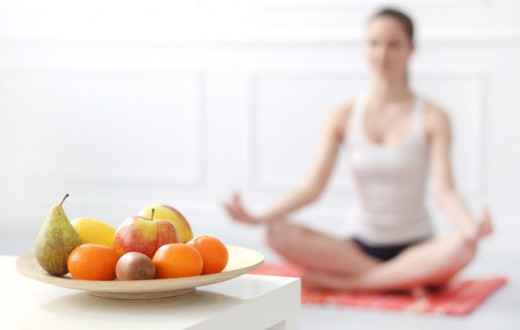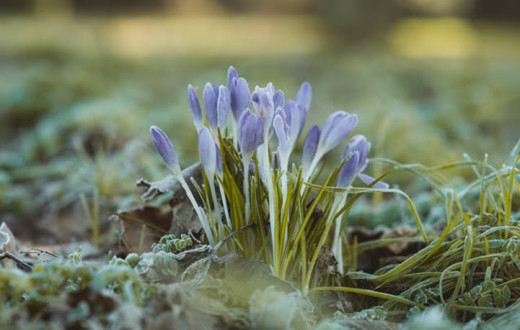By Elizabeth Herman | Posted: October 30, 2019
Do you sometimes feel a dip in physical energy? Especially in winter, about 1 in 15 people suffer from seasonal affective disorder, also interpreted to be winter tiredness. Or, do you worry that your clothes aren’t fitting as well due to sudden weight gain? If either or both of these are happening, it sounds like you have a high amount of earth element in you.
According to Ayurveda, our body is made up of five elements and three doshas (the bio-dynamic forces) - Vata (wind), Pitta (fire), and Kapha (earth). When these three doshas are in balance, they correspond to your best physical and mental traits, and as a result, you enjoy good health.
But at other times, there may develop an imbalance in these three doshas and they will then correspond to symptoms that may cause difficulty. An imbalance can result from improper diet, the influences of different times of day, seasonal changes, etc.
Signs of Kapha imbalance:
Colds with excessive mucus
Sinus pain and pressure
Disturbed bowel movements (diarrhea or constipation)
Sudden weight gain
Dips in physical strength
If you’re experiencing these, then you may have a Kapha dosha imbalance. You need Kapha balancing recipes and foods.
Protips:
Bitter, astringent and pungent tasting food will help in balancing Kapha dosha.
Excessive food consumption can lead to Kapha imbalance.
Eat light and easy-to-digest meals.
Reduce sugar in your Kapha dosha recipes.
Honey is a better sweetener for Kapha.
Kapha balancing recipes
1. Kapha salad
Ingredients:
¼ cup mung bean sprouts
2 grated carrots
Lettuce (romaine, spring mix, arugula, butter crunch)
Lemon
Oil
Salt to taste
Ground black pepper
Directions:
Combine sprouts and vegetables together in a bowl.
Drizzle lemon juice and/or oil over the salad.
Add salt to taste.
Toss and serve.
Special suggestions:
In general, most pungent and bitter vegetables may be used in kapha dosha recipes. Choose and add from this list - beet greens, beets (see below for how to steam raw beets), bitter melon, broccoli, cabbage, carrots, cauliflower, corn, green beans, green chilies, leafy greens, lettuce, mustard greens, okra, lemons, and limes.
As part of the salad dressing for this recipe for kapha, you may choose from among these: lemon, wholegrain prepared mustard or dry powdered mustard, raw honey, olive oil, thyme, salt (only the minimum amount) & black pepper.
2. Kapha pacifying soup
Ingredients:
7 cups (approximately) cauliflower
1 large head of broccoli
4 to 5 cups water
2 teaspoons (tsp.) coriander
1 tsp. fenugreek
1 tsp. cinnamon
½ tsp. turmeric
1 pinch hing or asafetida
½ tsp. black pepper powder
2 tablespoons (tbsp.) ghee, sesame oil, or olive oil
1 tsp. salt
Directions:
Cut and boil the cauliflower and broccoli with water on a low fire. Once done, keep aside.
Warm the ghee. Add the spices, until you can smell an enticing aroma that fills the room.
Add the spices to the vegetables and sprinkle salt to taste.
Mash with a masher and serve hot.
3. Khichadi (millet and lentils)
Ingredients:
¾ cup pearl millet
½ cup split moong dal (also known as green gram)
For sauté and garnish:
1 tsp. cumin
¼ tsp. turmeric
2 tsp. coriander
1 tsp. cinnamon
A few curry leaves
10-12 black peppercorns
1 tsp. rock salt
1 -2 tsp ghee
Directions:
For one portion of millet and moong, add 5-6 times as much water and cook on a low fire.
If required, add more water while cooking.
When soft, remove from heat and sauté the spices in ghee.
Add sautéed spices and salt to taste, mixing well.
Add ghee to garnish.
Special suggestions:
Khichadi, prepared with rice instead of millet and split moong dal, is beneficial for fever or stomach ailments.
It’s advisable to eat it with ghee or butter throughout pregnancy.
Due to its light, heating and drying effect, millet is beneficial for dull digestive fire, when your bowel movements become irregular. Therefore, it’s a useful addition to your kapha recipe collection. It’s also used to cleanse the digestive tract.
4. Pearl millet flat bread
Ingredients:
2 cups bajra flour
Ghee for serving
Directions:
Mix bajra flour and sufficient water in a bowl and knead into a soft dough.
Divide the dough into equal, large balls.
Generously sprinkle bajra flour on a ball of dough, and flatten it with your hands to make rotis.
Heat a pan and place the roti on it.
Pat the roti with water.
Once the roti dries up, flip it and cook evenly.
Apply ghee to taste and serve hot.
5. Leafy greens with chickpeas
Ingredients:
4 cups of chopped baby spinach
1 cup of cooked chickpeas
2 tsp. coconut oil
2 tsp. coriander seeds
1 tsp. cumin seeds
½ inch knob of ginger, chopped
2 tbsp. coriander leaves, chopped
2 tbsp. powdered cashew nuts
Salt to taste
Oil spray
1 tbsp. lemon juice
Directions:
Wash the spinach and cut finely.
Add ginger and coriander leaves to it and cook, stirring frequently for about five minutes and then turn off.
Warm the ghee in the saucepan. Add the cumin and coriander seeds; stir-fry until the coriander seeds become slightly darker.
Add the spices to the spinach mix.
Mix and mash the mixture with a masher; add enough water to make a thick paste.
Add the chickpeas and let the mixture boil.
Add the powdered cashew nut and let the mixture simmer.
Turn off the heat.
Add the lemon juice and salt to taste.
Serve this kapha dosha remedy hot with millet rotis.
6. Sesame seed rolls with ginger
Ingredients:
1 cup black sesame seeds
¼ cup cashew nuts
1 cup powdered jaggery
1 cup water
1 tsp. cardamom powder
1 tsp. ginger powder
Ghee as needed for shaping
Directions:
Roast the black sesame seeds in a pan on a low flame till they change color, and mash them with a pestle and mortar.
Add jaggery in water and ginger powder to it.
Now, add powdered cashew nuts to it and mix well.
Use ghee to make round balls.
7. Steamed beets
Ingredients:
2 whole beets, ends trimmed off, washed, skin on
Dash of apple cider vinegar
Dash of olive oil
Salt and pepper to taste
Directions:
Place the whole beets in a steamer and steam for 30 minutes.
Remove beets from steamer and allow to cool for 10 minutes.
Using paper towels, rub the outside edges of the beets until all the skin has peeled off. Discard the skin.
Slice, grate, or cube the beets and briefly marinate in olive oil, apple cider vinegar (minimum), and salt and pepper to taste. Eat plain, as a delicious side dish, or add to kapha salad as shown above.
These kapha pacifying recipes can help you stabilize the cold and dry feeling caused by the imbalance. Some Ayurvedic therapies may also help you balance kapha dosha.
For more information about Ayurvedic cooking courses or treatments, contact Shankara Ayurveda Spa.
Based on input from Dr. Sharika Menon, Ayurvedic doctor
This content is not intended to be a substitute for professional medical advice, diagnosis or treatment. Always seek the advice of your physician or other qualified health providers with any questions you may have regarding a medical condition.
Elizabeth Herman writes, offers writing support to clients, teaches, and volunteers for a better world. She has a PhD in Rhetoric, Composition and Literature. Find her on Facebook or Twitter.





























